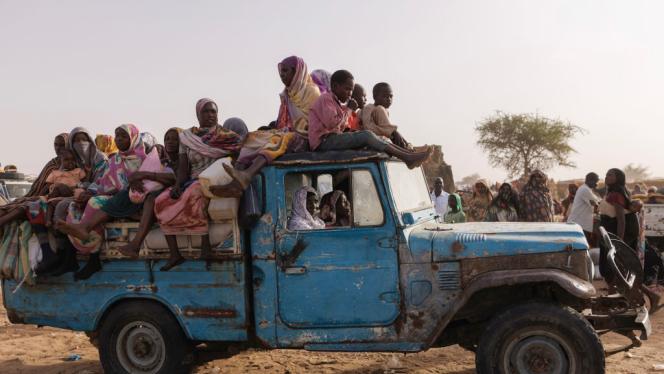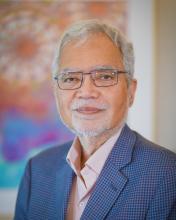Thursday 21 November 2024
There will be no peace in Sudan until the Darfur genocide is squared

Sudan’s ongoing suffering will persist until the debts of history are reconciled and addressing the conflict in Darfur is crucial for sustainable peace
“Tell President Omar al-Bashir that I will not sign the peace agreement unless Darfur is resolved,” asserted John Garang, chairman of the Sudan People’s Liberation Movement/Army, when we met at ‘New Site,’ his headquarters deep in the southern Sudanese bush.
I returned hastily to Khartoum, my base as Head of the United Nations system in Sudan. “Don’t worry, Dr Kapila, we will make peace but be patient while we implement the final solution in Darfur,” was the chilling response from al-Bashir’s top official. His choice of words left no ambiguity.
This chilling exchange in 2003 concerned the faltering peace talks between the authoritarian, Arab-supremacist regime in Khartoum and the predominantly black African and Christian South. The negotiations were held in the Kenyan resort of Naivasha under the auspices of the African Union’s subregional body, the Intergovernmental Authority on Development (IGAD), and were backed by the troika of the UK, the US, and Norway. I represented the UN’s humanitarian track.
As is often the case with such processes, not much happens in the conference room, leaving diplomats plenty of time in the bar, ostensibly to build relationships. The principal topic over the gin and tonics in Naivasha was who would receive the Nobel Peace Prize for ending Africa’s longest-running civil war in the continent’s then-largest country.
But it was not to be. The signing of the so-called Comprehensive Peace Agreement between the Sudanese government and the SPLM/A, which anticipated South Sudan’s independence, was delayed until 2005. This delay allowed ample time for the Millennium's first genocide to unfold in Darfur.
To understand how this happened, we must look further back. Darfur was an independent Sahelian sultanate until its conquest by Anglo-Egyptian Sudan in 1916 and its subsequent automatic transfer to independent Sudan in 1956. Its people—drawn from various groups such as the Masalit, Zaghawa, and Fur—had always been marginalised compared to the Arabs who prospered along the Nile and practised the enslavement of Africans.
The weaponisation of ethnicity further intensified in the 1980s as various strongmen vied for central control in Khartoum, invoking an Islamist ideology and manipulating deeply ingrained racist social attitudes.
The African-origin southerners rose up against Khartoum, forcing the government to negotiate in Naivasha. Meanwhile, various Darfuri rebels, particularly the Sudan Liberation Army and the Justice and Equality Movement, with similar grievances, were learning quickly. As they told me, if the southern Sudanese gained concessions through fighting, why shouldn’t they?
This alarmed President al-Bashir’s powerbase, the Sudan Armed Forces (SAF) and the feared National Intelligence and Security Service (mukhabarat). Reeling from their defeat in the south, losing Darfur posed an existential threat to them.
Meanwhile, western pressure to secure the Naivasha agreement intensified. The Darfur insurgency, which was obstructing the agreement, had to be suppressed by any means necessary. Consequently, Khartoum’s full fury was unleashed on Darfur. The 2003 US invasion of Iraq focused the government’s attention, as did the memory of the 1998 US bombing of an alleged chemical weapons factory in Khartoum. To avoid foreign intervention, it was deemed best to resolve the internal issues ourselves, according to my mukhabarat contacts.
I had a front-row view of what followed in Darfur: mass killings, rapes, burned villages, destroyed food and water supplies, and the displacement of populations, all intended to systematically and permanently destroy an ancient way of life. The rebel leaders contacted me in my UN role, and the intermediaries I sent across the border from Chad brought back graphic video evidence of mass atrocities.
However, this did not affect everyone equally. Only Darfuris of African ethnicity were subjected to cleansing. When I remonstrated with the authorities, the walis (governors) in Nyala and el-Fasher asserted that the zurga and abeed (black slaves) must be eliminated. The task was assigned to the SAF and the Janjaweed, a brutal Arab militia nicknamed “devils on horseback,” reinforced by like-minded kin from Libya and Chad.
I recognised the rhetoric, tactics, and patterns in Darfur from my own experience of the Rwandan genocide during its “one hundred days of killings” in 1994. The world had subsequently pledged “never again,” yet here was the first genocide of the 21st century unfolding “on my watch.”
I embarked on an intensive tour of key world capitals. The sympathetic ones provided me with classified intelligence, including satellite imagery that confirmed my worst fears. However, the west was reluctant to act, as doing so might distract the coalition supporting the Iraq war. My own superiors at UN headquarters in New York instructed me to remain silent when I requested to brief the Security Council. A senior colleague told me that they would not expend the political capital of the UN secretary-general on a “tribal conflict in a remote African corner where people had always massacred each other”.
Thus, the 21st century’s first genocide unfolded in Darfur. It was also the world’s first preventable genocide. Because, unlike previous cases, we were in the modern digital and communication age. Never before in history had we observed so much, documented so fully, and communicated so fast. With ignorance not being an excuse, I despaired. But this quickly turned into fury at betrayal by the principal global institution created after the invention of the word ‘genocide’.
So, I decided that if world leaders would not heed my warnings, I would appeal to the world’s people. I detailed Darfur’s sufferings to the global media, which embarrassed the UN and threatened my high-flying career. More seriously, it attracted death threats that forced me to leave Sudan.
But the genie was out of the bottle. The UN and key countries reversed their positions, and within days the first Security Council statements emerged, followed by resolutions that authorised peacekeepers and referred the situation to the International Criminal Court. These developments occurred only because the UNSC was not obstructed by Russia, distracted by internal problems, or by China, which was concerned about boycotts of its 2008 Beijing Olympics—threatened with being dubbed the “Genocide Olympics,” echoing Hitler’s 1936 Games.
President al-Bashir was duly indicted in 2009, marking the first time a serving head of state was charged, and the ICC brought genocide charges for the first time.
However, international action came too late, and 300,000 Darfuris died. Yet they were not entirely extinguished. Instead, around 3 million—about half the population—were forced into internally displaced persons (IDP) camps such as Zamzam and suffered under dire desert conditions in eastern Chad. The final chapter of the ethnic cleansing involved the Janjaweed and other Arab settlers occupying the vacated homes and fields of their victims.
With the perpetrators of the Darfur genocide enjoying impunity and the cries of victims unheard, the army consolidated its lucrative control over the military-industrial complex. However, President al-Bashir was concerned that the SAF’s dominance could threaten his dictatorship. To counterbalance this, he created the Rapid Support Forces (RSF) in 2013 from the Janjaweed and appointed a veteran leader of the Darfur atrocities, Hamdan Dagalo (Hemedti), also known as Hemedti, to lead them. Empowering Dagalo would later become one of his greatest blunders.
The RSF honed their combat skills further as mercenaries in Yemen. Additional wealth came from partnerships with Russia’s Wagner Group and dubious smuggling and trading enterprises, particularly gold mining in Darfur. Their consolidation of power was evident when they were entrusted with border control responsibilities, funded through European Union migration control projects.
It is a tragedy for Sudan’s diverse peoples to be divided and exploited by opportunistic leaders. My interactions as UN chief in Sudan revealed that the elites around relatively prosperous Khartoum were indifferent to Darfur. It was too distant, and the suffering of those not of their kin seemed irrelevant. History shows that genocides result from both passive and active complicity by society.
There is a broader African tragedy. Despite Pan-African rhetoric and calls for “African solutions to African problems,” the AU-mandated, South African-led peace process was glaringly biased, with Bashir remaining free and empowered despite his ICC indictment. This process even spared him from arrest during the 2015 AU Summit in South Africa.
Meanwhile, Sudan prospered as a petrostate, its wealth controlled by elites largely unaffected by long standing western sanctions. The poor suffered, and eventually, enough became enough. Social unrest in 2019, demanding al-Bashir’s removal, briefly offered the promise of a transition to civilian democracy. The former president was conveniently detained by his army protégés—not for the ICC charges, but for relatively minor corruption.
In the excitement of the moment, the international community lost sight of high-minded principles of justice and accountability. Despite protests from Sudanese civil society, they encouraged negotiation with and accommodation of the SAF and RSF, the direct descendants of the Darfur genocidaires.
As often happens with those united solely by a shared ideology of malign intent, the competing ambitions of the SAF and RSF eventually led to their fragmentation. The latest phase of Sudan’s civil war erupted in April 2023.
Sudan’s consequent agony has escalated dramatically. It is now the world’s largest humanitarian crisis, with 26 million—more than half the population—facing acute hunger and pockets of famine. Eleven million people are displaced, including over two million refugees. Healthcare and water provision have largely disappeared, and aid is routinely attacked, blocked, and stolen. Sexual violence is widespread, and atrocities are committed by all sides.
While the entire country is affected, Darfur remains at the heart of the crisis, with the RSF striving to complete what their Janjaweed predecessors began. The victims today are the same as they were two decades ago—Darfuris of African descent. The tactics are similar too: destruction of their way of life, mass displacement, starvation, and sexual violence. Independent inquiries confirm these as violations of the Genocide Convention.
We should not be surprised. The logic of unchecked genocide tends towards its completion. In Europe, the Holocaust of the 1940s was preceded over centuries by repeated purges of the Jews. In Rwanda, “practice genocides” over several decades preceded the genocide in 1994. Armenians and Yazidis have faced cyclic persecution since Ottoman times, with the former experiencing genocidal depths in 1915 and the Islamic State nearly exterminating the Yazidis between 2014 and 2017.
History provides further insight. While most wars are marked by violations of humanitarian law and even crimes against humanity, they eventually end when one side prevails. However, conflicts that reach the threshold of genocide do not necessarily end with the assertion of one side’s supremacy. Genocide often recurs sooner or later.
Preventing such recurrence has consistently required decisive external military intervention, accountability, justice, and restitution. This was evident with the conclusion of the Second World War, the fight-back in Rwanda, and the interventions in Cambodia and Iraq. Meanwhile, genocidal processes affecting the Rohingya in Myanmar, the Uyghurs in China, and the Tigrayans in Ethiopia remain unresolved, making continued genocidal violence a likely outcome.
The deployment of international peacekeepers interrupted the first Darfur genocide two decades ago and initiated a judicial process. However, this effort was not followed up with accountability, allowing impunity to flourish. The perpetrators remained in power and are now reoffending, illustrating another crucial lesson: unaddressed genocide does not remain contained. Not only is genocide reoccurring in Darfur, but the associated conflict has engulfed all of Sudan.
Sudan’s ongoing suffering will persist until the debts of history are reconciled. The current conflict, which began in Darfur in 2003, will need to be resolved there through justice, restitution, and ultimately reconciliation. The specifics of how and when this will occur remain uncertain, but taking shortcuts through unprincipled compromises with perpetrators will only lead to further suffering.






